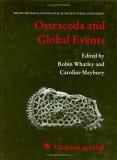Fossil ostracods
- 15th International Symposium on Ostracoda

- A First Record of a Strike-slip Basin in Western Anatolia and Its Tectonic Implication: The Cumaovası Basin

- A New Cenozoic Deep-Sea Genus, Abyssocythere (Crustacea: Ostracoda: Trachyleberididae), with Descriptions of Five New Species

- An ostracode turnover during the Eocene-Oligocene climate transition in Mississippi, the Gulf Coast Plain, USA

- Arctic Ostracode Database
- Atlas of the Pannonian and Pontian ostracods from the eastern area of the Pannonian Basin

- Bathonian and Lower Callovian ostracods of Albstadt-Pfeffingen Middle Jurassic, Baden-Württemberg, Germany)

- Benthic ostracods from the Early-Middle Frasnian transition in the north-western East European Platform, Russia

- Biozonation et paléoenvironnement des ostracodes du Paléogène du Sénégal occidental (Afrique de l’Ouest)

- Catalog of Type Specimens of Invertebrate Fossils: Conodonta

- Cretaceous ostracodes from Pará-Maranhão Basin, Brazil: taxonomy and preliminary paleoecological and paleobiogeographical inferences

- Description of Pseudocandona serfozoin. sp. (Crustacea, Ostracoda, Candonidae) from Romania

- Early Palaeocene Ostracoda from the Cretaceous–Tertiary (K-T) Deccan Intertrappean sequence at Jhilmili, district Chhindwara, Central India

- Early Pliocene Brackish And Freshwater Ostracoda From The Valdelsa Basin (tuscany, Central Italy)

- Evolution of Oblitacythereis from Paleocosta (Ostracoda: Trachyleberididae) during the Cenozoic in the Mediterranean and Atlantic

- First Records of Late Devonian Entomozoacean Ostracods in North-western Turkey

- Fractal analysis of ostracod shell variability: A comparison with geometric and classic morphometrics

- Fresh and Brackish Water Ostracods of Upper Miocene Deposits, Arguvan/Malatya (Eastern Anatolia)

- Freshwater ostracods as palaeoevironmental proxies in the Moervaart Depression, a palaeolake in Sandy Flanders (NW Belgium)

- Freshwater Ostracods from Neogene deposits of Develiköy (Manisa, Turkey)

- Freshwater ostracods (Ostracoda) and Upper Miocene paleobiotopes of the northern part of the Turiec Depression (Slovakia)

- Gault Microfossils - Ostracoda
- Geometric Morphometrics and its use in ostracod research: a short guide

- IRGO-International Research Group on Ostracoda - An interdisciplinary, international organization of about 400 research scientists studying living and fossil Ostracoda. Its purpose is to advance our knowledge of Ostracoda and to facilitate communication among researchers.
- Late Cenozoic Ostracoda of the South Aegean Island Arc
- Late Cenomanian ostracode faunas from the area south of Ain Sukhna, western side of the Gulf of Suez, Egypt

- Late Miocene non-marine ostracods from the Lake Küçükçekmece region, Thrace (Turkey)

- Late Miocene ostracodes of Serbia: morphologic and palaeoenvironmental considerations

- Le Paléogène des synclinaux du Jura et de la bordure sud-rhénane: paléontologie (Ostracodes), paléoécologie, biostratigraphie et paléogéographie

- Maastrichtian-Early Eocene ostracodes from west-central Sinai, Egypt - taxonomy, biostratigraphy, paleoecology and paleobiogeography

- Maeotian / Pontian ostracods in the Badislava –Topolog area (South Carpathian Foredeep-Romania)

- Middle Eocene ostracodes of the Qattamiya area, northwest Eastern Desert, Egypt : Systematics, biostratigraphy and paleobiogeography

- Middle Miocene ostracods of the Fore-Carpathian (Central Paratethys, southwestern Poland)

- Middle Tertiary Ostracoda from northwestern Puerto Rico

- Myodocopid Ostracoda from the Late Permian of Greece and a Basic Classification for Paleozoic and Mesozoic Myodocopida

- New insights into the early diversification of the Ostracoda: Tremadocian ostracods from the Cordillera Oriental, Argentina

- Ordovician ostracods from east central Iran

- Ostracoda Biostratigraphy and Chronostratigraphy of Pannonian-Pontian Sequence of Gelibolu Peninsula, NW Turkey

- Ostracod fauna across the Permian-Triassic boundary at Chongyang, Hubei Province, and its implication for the process of the mass extinction

- Ostracod Fauna And Environmental Characteristics Of The Volcano Sedimentary Yol Üstü Formation In The Hinis Region, Erzurum (Eastern Anatolia), Turkey

- Ostracod Group. The Micropalaeontological Society
- Ostracoda from DSDP Leg 42B (Black Sea)

- Ostracoda from the Gaindorf Formation (Middle Miocene, Lower Badenian) of Mühlbach (Molasse Basin, Lower Austria)

- Ostracoda from the Late Permian of Greece (Thaumatocyprididae and Polycopidae)

- Ostracoda List Server
- Ostracode faunal changes through the Paleocene-Eocene thermal maximum at Ocean Drilling Program Site 865, equatorial Pacific

- Ostracode record from the middle Cenomanian – early Turonian of Central Jordan: Taxonomy and palaeoecology related to Oceanic Anoxic Event 2

- Ostracodologists at UFRGS - Brazil
- Ostracods and the biological crisis of Middle-Upper Permian boundary

- Ostracods across the Permian-Triassic boundary in Western Tethys: The Bulla parastratotype (Southern Alps, Italy)

- Ostracods and rock facies across the Givetian/Frasnian boundary interval in the Sourd d’Ave section at Ave-et-Auffe (Dinant Synclinorium, Belgium)

- Ostracods and stable isotopes: proxies for palaeoenvironmental reconstructions

- Ostracods From The Global Stratotype Section For The Base Of The Aalenian Stage, Jurassic At Fuentelsaz Section (Cordillera Ibérica, Spain)

- Ostracods from the Middle Triassic Sina Formation (Aghdarband Group) in NE-lran)

- Ostracods of the Gault Clay
- Ostracods of the Paratethyan Neogene Kılıç and Yalakdere Formations near Yalova (İzmit Province, Turkey)

- Ostracods of the Upper Pliocene - Pleistocene Punta Mazza succession (NE Sicily) with special focus on the Family Trachyleberididae Sylvester-Bradley, 1948, and description of a new species

- Paleo-temperature shifts and gradients of intermediate and shallow waters in the Sea of Japan during the Late Pliocene estimated by Mg/Ca ratio of ostracod valves

- Palaeoenvironmental Evolution Of The Plio-pleistocene Monte Mario Succession (Rome, Italy) Inferred From Ostracod Assemblages

- Paleocene – Lower Eocene ostracods from the Southern Galala Plateau area (Eastern Desert, Egypt): impacts of tectonics and platform evolution on ostracode distribution

- Phylogeny, palaeoecology, and invasion of non-marine waters by the late Miocene hemicytherid ostracod Tyrrhenocythere from Lake Pannon

- Pontian aged Loxoconcha (Ostracoda) species from eastern Black Sea Region of Turkey

- Recent benthic Ostracoda from the sediments of Ennore Creek, Chennai, Tamilnadu, India

- Sarmatian (Middle Miocene) ostracod fauna from the Zsámbék Basin, Hungary

- Soft body morphology, dissection and slide-preparation of Ostracoda: a primer

- Stratigraphical distribution of Givetian ostracods in the type-area of the Fromelennes Formation (Fromelennes, Ardennes, France) and their relationship to global events

- Upper Miocene freshwater ostracods (Ostracoda) of the littoral deposits of the Turiec Formation

- Upper Permian ostracode assemblage from the Jadar Block (Vardar zone, NW Serbia)

Books about fossil ostracods





